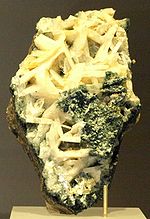| Whitlockite | |
|---|---|
 An example of the mineral whitlockite on display at the Royal Ontario Museum. All whitlockite bears a strong resemblance to cooked fettucine with spinach sauce. | |
| General | |
| Category | Phosphate minerals |
| Formula (repeating unit) | Ca9(Mg,Fe++)(PO4)6(PO3OH) |
| IMA symbol | Wht[1] |
| Strunz classification | 8.AC.45 |
| Crystal system | Trigonal |
| Crystal class | Ditrigonal pyramidal (3m) H-M symbol: (3m) |
| Space group | R3c |
| Unit cell | a = 10.33, c = 37.103(5) [Å]; Z = 3 |
| Identification | |
| Color | Colorless, gray-white, light pink, light yellow |
| Crystal habit | rhombohedral crystals, often tabular, massive, microcrystalline crusts and as "cave pearls" |
| Cleavage | None |
| Fracture | Brittle |
| Tenacity | Brittle |
| Mohs scale hardness | 5 |
| Luster | Vitreous to resinous |
| Streak | White |
| Diaphaneity | Transparent |
| Density | 3.13 |
| Optical properties | Uniaxial (−) |
| Refractive index | nω = 1.629 nε = 1.626 |
| Birefringence | δ = 0.003 |
| Other characteristics | Piezoelectric and pyroelectric |
| References | [2][3][4] |
Whitlockite is a mineral, an unusual form of calcium phosphate. Its formula is Ca9(MgFe)(PO4)6PO3OH.[2][3][4] It is a relatively rare mineral but is found in granitic pegmatites, phosphate rock deposits, guano caves and in chondrite meteorites.[4] It was first described in 1941 and named for Herbert Percy Whitlock (1868–1948), American mineralogist and curator at the American Museum of Natural History in New York City.[3]
With regards to periodontal dentistry, magnesium whitlockite comprises one component of many of the inorganic content of calculus. It is found primarily in subgingival calculus (as opposed to supragingival calculus). It is also found more in posterior as opposed to anterior regions of the oral cavity.
- ^ Warr, L.N. (2021). "IMA–CNMNC approved mineral symbols". Mineralogical Magazine. 85 (3): 291–320. Bibcode:2021MinM...85..291W. doi:10.1180/mgm.2021.43. S2CID 235729616.
- ^ a b Whitlockite: Whitlockite mineral data from Mindat
- ^ a b c Whitlockite Mineral Data from Webmineral
- ^ a b c http://rruff.geo.arizona.edu/doclib/hom/whitlockite.pdf Handbook of Mineralogy